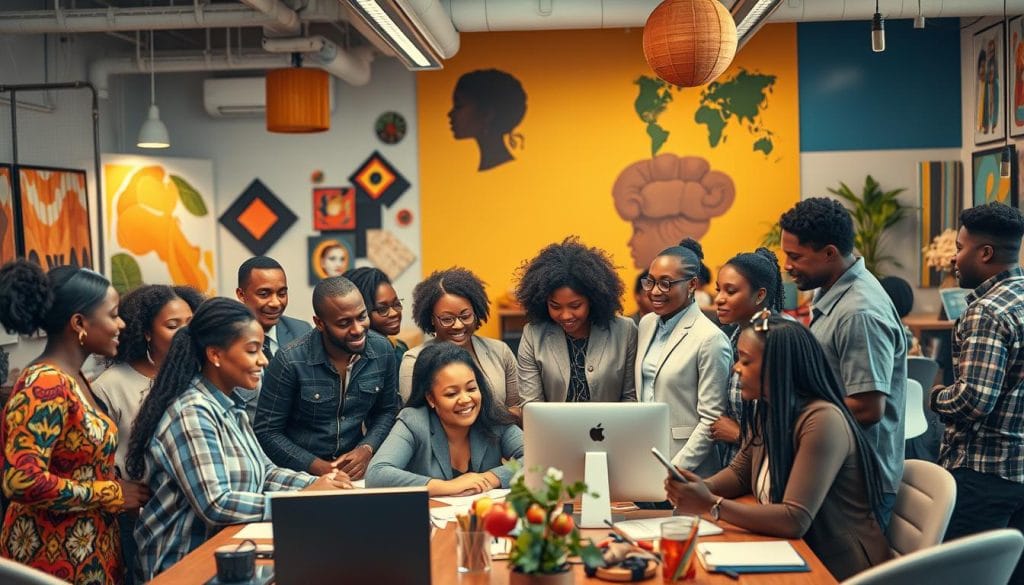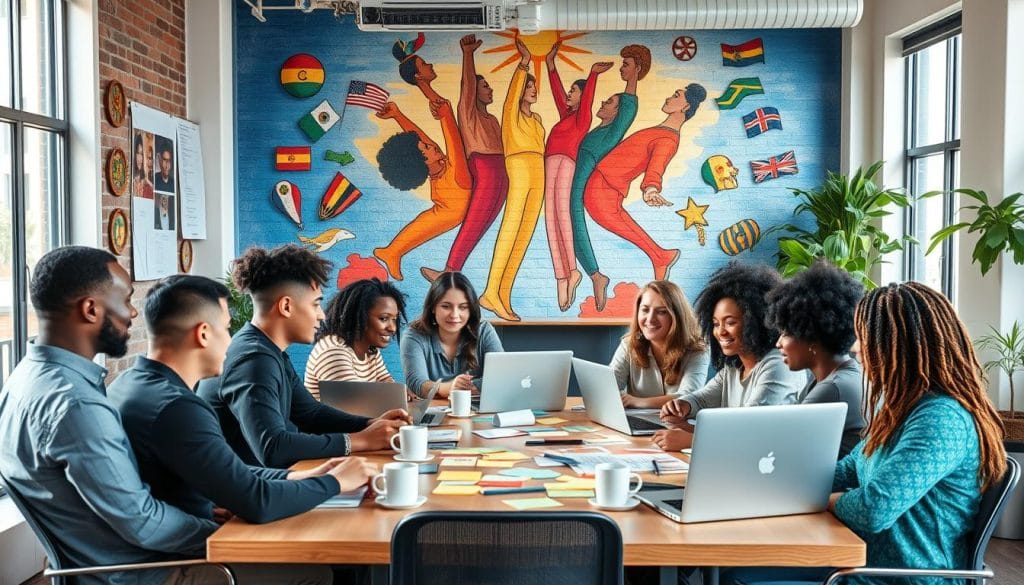About 70% of U.S. companies celebrate Black History Month. But, only a few keep working on diversity, equity, and inclusion all year. Black History Month is crucial, showing how African American History shaped the Civil Rights Movement. It’s important to support diversity, equity, and inclusion all year, not just in February.
The Civil Rights Movement has changed America forever. It’s thanks to key figures who left a lasting mark. By learning about Black History Impact and African American History, we can make our world more inclusive. We can celebrate diversity all year, not just in one month.
Key Takeaways
- Recognize the significance of Black History Month and its impact on American society
- Extend diversity, equity, and inclusion efforts beyond February
- Understand the importance of African American History and the Civil Rights Movement
- Champion diversity, equity, and inclusion in all aspects of life
- Create a more inclusive environment that celebrates diversity year-round
- Support organizations that prioritize diversity, equity, and inclusion
Understanding the Importance of Black History Impact
Black history has a big impact on today’s world. Historical Achievements and Black Culture Contributions have shaped our nation. Education helps us celebrate these contributions all year, not just in February.
It’s important to see how Black history affects us. Racial Equality Events celebrate Black culture and bring us together. These events help us value diversity and inclusion.
Defining Black History Impact in Today’s Society
Black history is more than the past; it influences our present. Historical Achievements have opened doors for the future. Black Culture Contributions keep shaping our culture. By celebrating these, we move towards a fairer society.
The Role of Education in Recognizing Contributions
Education is crucial for honoring Black contributions. By adding Black history to school lessons, we teach future generations about Black Culture Contributions and Historical Achievements. We can do this in many ways, like:
- Adding Black history to school curricula
- Supporting teachers with resources
- Getting the community involved
Celebrating Black History Beyond February
We shouldn’t just celebrate Black history in February. Racial Equality Events can happen all year, fostering unity and inclusion. By joining these events, we show our support for diversity and honor Black Culture Contributions and Historical Achievements.
The Role of Organizations in DEI Efforts
Organizations are key in promoting diversity, equity, and inclusion (DEI) in the workplace and beyond. By embracing Black Excellence Influence, companies can create a culture of inclusivity. This drives Social Justice Progress. Effective DEI strategies include diversity training, inclusive hiring, and safe spaces for discussion.
Leadership commitment to DEI is vital. It sets the tone for the whole organization. When leaders prioritize DEI, it sends a strong message to everyone. Companies like Microsoft and Google have shown success by aligning their values with DEI goals. This has led to a more diverse and inclusive workforce.
Implementing Effective DEI Strategies
To implement effective DEI strategies, organizations can follow these steps:
- Conduct a diversity and inclusion audit to identify areas for improvement
- Develop a comprehensive DEI plan with clear goals and objectives
- Provide diversity and inclusion training for all employees
- Create a safe and inclusive work environment

Aligning Organizational Values with DEI Goals
Aligning organizational values with DEI goals is essential for inclusivity. This can be achieved by:
- Integrating DEI into the company’s mission and vision statement
- Establishing a diversity and inclusion committee
- Recognizing and celebrating diverse holidays and events
By implementing effective DEI strategies and aligning organizational values with DEI goals, companies can promote Black Excellence Influence. This contributes to Social Justice Progress. It benefits the organization and the community at large.
Best Practices for Celebrating Diversity Year-Round
Celebrating diversity is a continuous effort that needs dedication from all. It’s key to make sure everyone feels valued and respected, no matter their background or identity. By tackling Diversity Struggles and pushing for Human Rights Activism, we aim for a fairer world.
To make progress, we must engage the community all year, not just during special days. This means supporting local diversity efforts, joining human rights campaigns, and building a culture of inclusivity. Here are some ways to celebrate diversity all year:
- Organize inclusive events that honor diverse cultures
- Back local groups that champion diversity and inclusion
- Join human rights movements and advocacy
By adopting these practices, we can build a society that values diversity and fights for human rights. Remember, celebrating diversity is a never-ending journey that needs everyone’s commitment.
Creating Inclusive Events
Special events can greatly help in promoting diversity and inclusion. Hosting events that celebrate different cultures and backgrounds can unite people. It helps build a sense of community and belonging.
Engaging the Community Beyond Celebrations
It’s vital to engage the community all year, not just during celebrations. This can be achieved by supporting local diversity initiatives, joining human rights campaigns, and creating an inclusive atmosphere. This way, we can build a more inclusive and fair society.
| Best Practices | Benefits |
|---|---|
| Creating inclusive events | Fosters a sense of community and belonging |
| Supporting local organizations | Promotes diversity and inclusion |
| Participating in human rights activism | Addresses diversity struggles and promotes human rights |
Employee Resource Groups: A Vital Component
Employee Resource Groups (ERGs) are key in building a sense of community at work. They help celebrate African American History and the Black History Impact. This makes the workplace more welcoming for everyone.
These groups offer a space for employees to share their stories and support each other. They also help educate others about the value of diversity and inclusion.
ERGs are great for career growth, letting everyone’s voice be heard, and celebrating different cultures. Some main benefits include:
- Creating a sense of community and belonging among employees
- Providing a platform for employees to share their experiences and support one another
- Educating colleagues about the importance of diversity and inclusion
- Celebrating cultural heritage and promoting Black History Impact
Supporting ERGs shows a company’s dedication to diversity, equity, and inclusion. This can boost employee happiness, keep them around longer, and improve overall well-being. Celebrating African American History and the Black History Impact is crucial. ERGs play a big part in making workplaces more diverse and inclusive.

Investing in ERGs makes workplaces more welcoming and supportive. This benefits both employees and the company. As we celebrate diversity, equity, and inclusion, we must recognize ERGs’ significant role in the workplace.
| ERG Benefits | Description |
|---|---|
| Community Building | Creating a sense of community and belonging among employees |
| Career Development | Providing opportunities for career advancement and growth |
| Cultural Celebration | Celebrating cultural heritage and promoting African American History |
Overcoming Challenges in DEI Implementation
Starting Diversity, Equity, and Inclusion (DEI) efforts can be tough. Yet, learning from the Civil Rights Movement and Historical Achievements of pioneers can help. These lessons can guide organizations past common hurdles in DEI.
Challenges like resistance to change, lack of resources, and unconscious bias often stand in the way. To beat these, companies can try a few things:
- Offer training and education on DEI topics
- Create employee resource groups for diverse employees
- Use inclusive hiring practices to bring in diverse talent
By using past successes to tackle today’s issues, companies can achieve DEI goals. The Civil Rights Movement and Historical Achievements of pioneers prove that hard work leads to progress. This progress helps build a more inclusive and fair society.
Measuring the Success of DEI Programs
To see if Diversity, Equity, and Inclusion (DEI) programs work, we need to set goals. We track how many underrepresented groups are in the workplace. We also use surveys to see how happy and included employees feel.
Black Culture Contributions are key in setting these goals. They help us understand what diverse groups need and go through. By listening to feedback from Racial Equality Events and other community efforts, companies can make their DEI plans better. This helps create a more welcoming place for everyone.
- Diversity metrics, such as representation and retention rates
- Employee engagement surveys, including feedback on inclusion and sense of belonging
- Feedback from community events, such as Racial Equality Events, to gauge the impact of DEI initiatives
By checking these KPIs often and using feedback to improve, companies can make sure their DEI work is doing well. This leads to a culture that values and respects Black Culture Contributions and Racial Equality Events.
| KPI | Description |
|---|---|
| Diversity Metrics | Track representation and retention rates of underrepresented groups |
| Employee Engagement Surveys | Gauge overall sense of inclusion and sense of belonging |
| Feedback from Community Events | Evaluate the impact of DEI initiatives, including Racial Equality Events |
The Role of Leadership in Driving DEI Forward
Leadership is key in pushing Diversity, Equity, and Inclusion (DEI) initiatives forward. By supporting Black Excellence Influence and pushing for Social Justice Progress, leaders can motivate their teams to aim for more equity and inclusion.
Leading by example is a crucial part of DEI leadership. This means being seen and actively involved in DEI work, like attending training and backing underrepresented groups. Leaders should also work to create a welcoming and respectful culture. This way, everyone feels important and able to share their ideas.
- Setting clear DEI goals and objectives
- Providing training and development opportunities for employees
- Encouraging open communication and feedback
- Holding themselves and others accountable for DEI outcomes
By doing these things, leaders can build a more welcoming and fair workplace. This benefits both employees and the company as a whole.
| Leadership Action | DEI Outcome |
|---|---|
| Leading by example | Increased employee engagement and participation in DEI efforts |
| Providing training and development opportunities | Improved knowledge and skills related to DEI |
| Encouraging open communication and feedback | Increased sense of inclusivity and respect among employees |
Community Partnerships: Expanding DEI Efforts
Community partnerships are key in growing Diversity, Equity, and Inclusion (DEI) efforts. Working with local groups, businesses can tackle Diversity Struggles and boost Human Rights Activism. This helps the community and improves the company’s image and social duty.
Collaborating with Local Organizations
Teaming up with local groups lets businesses understand community needs. This can happen through volunteering, sponsorships, or shared projects. For example, companies can team up with local charities to help underprivileged groups, tackling Diversity Struggles and supporting Human Rights Activism.
Amplifying Voices Through Partnerships
These partnerships also help bring attention to social issues. By joining forces, businesses and groups can make a stronger voice for Human Rights Activism. This can be done through shared campaigns, events, or social media efforts. For instance:
- Hosting workshops and training sessions on diversity and inclusion
- Creating awareness campaigns on social media to promote human rights
- Developing community programs to support marginalized groups
By building community partnerships, businesses can grow their DEI efforts and positively impact society. This not only boosts the company’s image but also helps create a more inclusive and fair world.
| Partnership Type | Benefits |
|---|---|
| Volunteer Work | Enhances company reputation, supports community development |
| Sponsorships | Supports local events, promotes business visibility |
| Joint Projects | Addresses diversity struggles, promotes human rights activism |
Continuous Education and Growth in DEI
The journey towards a more inclusive society is ongoing. Celebrating Black History Month is a good start. But, real progress comes from a lifelong commitment to learning.
There are many resources to learn about the Civil Rights Movement and Black Americans’ contributions. Books, documentaries, and online courses are just a few examples. These opportunities are vast and easy to find.
By using these resources, we can better understand DEI issues. This helps us become stronger advocates for change. Workshops and training sessions offer valuable insights and strategies for promoting diversity and inclusion.
